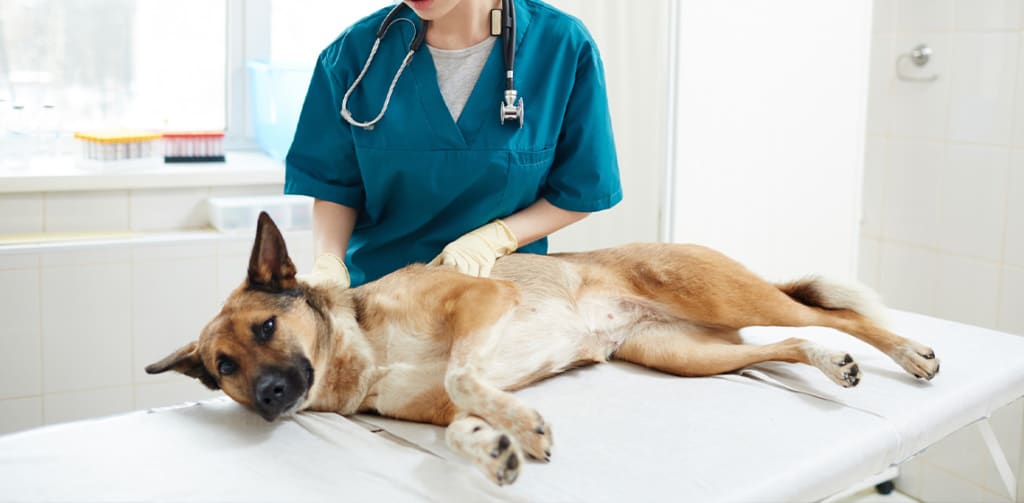If your dog shows signs that could indicate a stroke, it can be a scary time. Symptoms tend to come on suddenly and can be severe. Here’s what you need to know.
Severity:
Often moderate to severe.
Table of Contents
Key points
- A stroke is caused by disruption to the blood flow to the brain due to blood clots or burst blood vessel.
- Symptoms of strokes in dogs can vary depending on what part of the brain is affected.
- Other conditions can make your dog more likely to have a stroke, including diabetes, Cushing’s disease, kidney disease, and heart disease.
- Quick treatment is vital after the stroke occurs.
- Although most dogs recover from a stroke if vets restore proper blood flow to the brain affected, recovery time can be variable, and symptoms can persist.
Common in:
Older dogs or those with certain ongoing illnesses
Dog Stroke Symptoms and types:
The symptoms of strokes in dogs are caused by a lack of blood flow to the brain and often come on very suddenly, with no prior warning.
The combination of symptoms can vary drastically between dogs, depending on which part of the brain affected. In human stroke victims, it often leads to slurred speech, a drop of one side of the face, or weakness of one side of the body.
On the other hand, if your canine companion has a stroke, it might cause them to become wobbly, weak, uncoordinated, or distressed. They may act out of character, seem less responsive or vacant, or even become aggressive.
You might notice that they appear blind or with abnormal eye movements, walk into things, and seem disorientated. If you look at their face, their head tilt, and their eyes might be flickering or rolling. In addition, affected dogs might walk in circles, struggle to stand, or have seizures.
Symptoms of a stroke come on suddenly and can include weakness, incoordination, walking in circles, tilting of the head, and seizures.
How Vets Diagnose Strokes in Dogs
As pet owners, if your dog is showing signs that they might be having a stroke, you must arrange for them to be examined by a veterinarian as an emergency, especially to prevent further strokes or brain diseases.
There also needs to be proper blood flow restored which is done through stroke treatment.
Just like strokes in humans, in order for treatment to be successful, it must be started promptly to avoid blood clots or clotting disorders which come from the rupture of blood vessels.
Once at the veterinary clinic, a veterinarian will be able to use various tests to decide whether the cause of your dog’s symptoms is a stroke or another medical issue.
- First, the veterinarian will complete a neurological examination to test your dog’s brain and nerve function. This involves stimulating various reflexes and assessing your dog’s response.
- To better understand the cause of the symptoms, your veterinarian might perform blood tests, x-rays of the chest or spine, a heart ultrasound, or an ECG.
- If your veterinarian has advanced imaging facilities, or if your dog is stable to travel to a specialist centre, they might recommend a CT, MRI, or fluoroscopy.
These tests will allow the veterinarian to assess your dog’s heart and circulation, as well as their brain and nervous system, to decide which is the source of their illness.
what causes strokes in dogs?
Strokes can be caused by an obstruction to a blood vessel or bleeding from a blood vessel. If a blood clot causes the stroke, it is known as an ischemic stroke. If blood clots form within the body, they can travel through the larger blood vessels without an issue but often get stuck within the smaller blood vessels of the internal organs.
Common places for clots to get stuck include the brain, lungs, and kidneys. When the blood clot gets lodged within the network of blood vessels in the brain, it causes a blockage, preventing oxygenated blood from reaching that area of the brain. Sometimes a similar blockage can be caused by other debris within the blood vessels, like clumps of bacteria or tumor cells.
If a portion of a blood vessel is weakened and stretched by an aneurism, or if there is trauma to a blood vessel, the blood vessel can burst to cause a bleed. The bleeding from the burst blood vessel prevents oxygenated blood from reaching the brain tissue, just like if there were an obstruction. This is known as a hemorrhagic stroke.
Once deprived of oxygen, either due to a clot or a bleed, the brain tissue will begin to die. Depending on the exact location of the clot or haemorrhage, different parts of the brain will be affected, which is why the symptoms are quite variable.
There is no effective home remedy, and you should phone a veterinarian immediately so that they can start investigations and treatment.
Best treatment options for dogs stroke
One of the most crucial parts of treating a stroke is treating the underlying cause, therefore preventing further damage.
- If the underlying cause of the stroke is heart disease, then, as well as blood thinners, your dog might benefit from diuretics and medication to control the blood pressure and help the heart pump more effectively. Similarly, treatment of any underlying conditions like diabetes, Cushing’s disease, or kidney disease will help to prevent any more stroke episodes.
- Anti-clot medication and blood thinners are helpful for any ischemic stroke. Although hemorrhagic strokes are harder to treat because the brain is not easy to reach surgically, the pressure on the brain from the bleed can be relieved with medication.
With close monitoring and treatment, many dogs will improve after suffering from a stroke. The recovery time can vary from a few weeks to a few months, and sadly some dogs never fully recover.
However, even if they have some long-term symptoms, the most important thing is whether they can still have a good quality of life.
With a little extra help from their pet parents, many dogs live happy lives, but if a good quality of life is not achievable, putting them to sleep may be the kindest option.
Stroke Home remedies and their effectiveness
Unfortunately, if your dog is showing signs of a possible stroke, then time is of the essence. There is no effective home remedy, and you should phone a veterinarian immediately so that they can start investigations and treatment.
When to see a vet
If you think your canine companion could be having a stroke, this is an emergency. Rather than waiting for more symptoms to develop, it is crucial to seek veterinary attention as soon as the stroke occurs.
Prompt veterinary treatment is very important, and any delay could have an impact on your canine companion’s long-term health.
FAQ
If your dog has a stroke, you should call a veterinarian immediately so that investigations and treatment can be started. Older dogs may take longer to recover, and other issues like arthritis can also hinder recovery. If an older dog has longstanding stroke symptoms and cannot reach their food and water or get out to pass urine or feces, euthanasia may be the kindest option.
Depending on the cause and the speed of treatment, some dogs can recover from strokes. However, recovery can take weeks or months, and some dogs never fully recover. Dogs with long-lasting symptoms may have life-long incoordination, head tilt, or blindness. If the longstanding symptoms are too severe to allow them to live a happy life, it may be kinder to perform euthanasia.
When a dog has a stroke, the blood flow to some parts of the brain is reduced, and this can cause the brain tissue to die. If caught early, the signs can be reversible. However, the longer that treatment is delayed, the more likely that the symptoms will remain.
The signs of a stroke can vary substantially between dogs, depending on what part of the brain is deprived of oxygen. Symptoms tend to come on suddenly and can include weakness, incoordination, walking in circles, tilting of the head, and seizures. Affected dogs may act strangely, appear blind, or become aggressive.

Dr. Hannah Godfrey MRCVS graduated from the Royal Veterinary College in 2011. Although she initially worked in mixed practice treating all species, she found a love for small animal work and has worked exclusively with dogs and cats since 2014. She lives in Wales with her partner, son, and two cats (named Poppy and Ashton Kutcher), and writes comedy fiction in her spare time.








